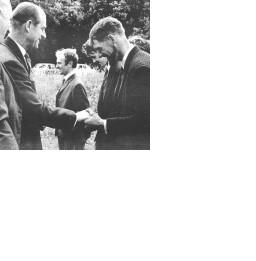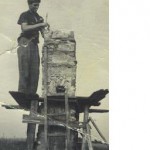By Jimper
The marshland around Rye when under the sea was the highway to Winchelsea and England. Naturally the soil was full of old rubbish, lost at sea in those days. It seemed that stone was carried by the ships as ballast and would be jettisoned into the bay before loading a cargo, for I can think of no other reason for so much of it lying under the ground. When the dykes were made out to a new depth after the flooding of the war, a lot of this stone appeared around the fields in the mud. Every spring as we started to lamb the ewes, father would look across the field and notice a sheep lying near a grey object that seemed to be a still lamb. Obviously something was amiss. A new lamb should be the mother’s pride and joy. She must be in trouble not to be with it. So I was sent across the fields in all weathers to investigate. Often it was one of those large stones that the rain had washed clean, that I was sent to assist. Something had got to be done so I recruited a mate of mine and began to gather all the stones together that were visible. With a spade and crowbar we loaded them all onto a trailer and tipped them into a corner of a field. At last no more false alarms from dad. This huge pile of rock gave me an idea. If I glued them together with cement, it would be a fitting reminder of all the hard work we had put into getting them. So a bag of cement dust and a pile of sand was acquired from my friend Maggot’s dad, who was a builder developing Winchelsea Beach. I set the very largest ones at the bottom, as they were too heavy to lift. A column of stone started to grow, four feet by four feet. At three feet high, I placed a house brick covered in sheet lead, marked out with a punch. 1940 water level to mark the depth it reached in the war when the marsh was flooded, my mate and I then had to build a scaffold to reach the level we were at and eventually we got to ten feet before we ran out of stone. Not being in the mood to import building materials, it stood for twenty years unfinished until we sold the ground and they took it away. In its short life, it was hit by lightening and split down one side. It was visible for miles, standing out on the marsh. People often asked if it was the chimney-stack of an old house. “No it’s just a pile of rock that saved my legs many miles”.

“Cinque Ports” April 2016
All articles, photographs, films and drawings on this web site are World Copyright Protected. No reproduction for publication without prior arrangement. © World Copyright 2017 Cinque Ports Magazines Rye Ltd., Guinea Hall Lodge Sellindge TN25 6EG
Jimper meets Phrince Phillip – One of the many people he has met in connection with work he has done for wildlife preservation

